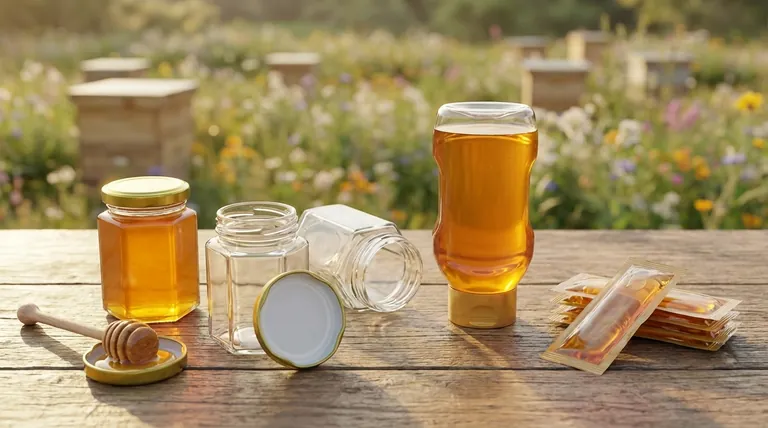The best packaging for honey is a strategic choice between two primary materials. For preserving the purest flavor and creating a premium image, glass is the superior option. For everyday convenience, durability, and cost-effectiveness in a retail environment, food-grade plastic like PET is the industry standard.
The decision of how to package honey extends far beyond the container itself. It is a critical choice that directly impacts product preservation, brand perception, user convenience, and overall production cost.

The Core Functions of Honey Packaging
Proper packaging is the first line of defense for your product. Its primary role is to act as a barrier between the carefully harvested honey and the outside world.
Protecting from Contaminants
Honey's quality degrades when exposed to the environment. An effective package must provide an airtight and moisture-tight seal to prevent spoilage and the growth of unwanted organic matter.
Preserving Flavor and Aroma
The container material should be inert, meaning it doesn't interact with the honey. This ensures the packaging does not impart any unwanted flavors or aromas, preserving the honey's natural taste profile.
Meeting Consumer Expectations
Modern consumers have clear expectations. They prefer transparent containers that allow them to see the honey's color and clarity, and there is a growing demand for packaging that is recyclable or biodegradable.
A Breakdown of Common Packaging Materials
Each packaging type serves a different segment of the market, from high-end artisanal products to convenient, family-friendly options.
Glass Jars: The Premium Standard
Glass is the traditional choice for honey and is widely seen as the premium option. It is completely non-porous and inert, making it ideal for long-term storage without any risk of flavor contamination. Its weight and clarity communicate quality to the consumer.
PET Plastic Bottles: The Versatile Workhorse
Plastic, particularly PET (polyethylene terephthalate), is the most common material in commercial honey packaging. It is lightweight, shatter-resistant, and less expensive to ship than glass, making it perfect for high-volume retail. Its flexibility allows for user-friendly designs like squeeze bottles.
Pouches and Sachets: The On-the-Go Solution
For single servings or specialized applications, flexible pouches and sachets are an excellent choice. They are extremely lightweight, highly customizable, and ideal for the food service industry or for consumers seeking portable, portion-controlled options.
Understanding the Trade-offs
Choosing a material is always a balance of competing priorities. Understanding these trade-offs is key to making the right decision for your specific business.
Cost and Weight
Glass is significantly heavier and more expensive to procure and ship than plastic. This directly impacts your profit margins and logistical costs, especially for large-scale distribution.
Brand Perception vs. User Convenience
A heavy glass jar conveys an artisanal, high-quality image. However, a plastic squeeze bottle offers unparalleled ease of use for the consumer, especially in a family setting, preventing sticky messes and allowing for controlled dispensing.
Environmental Impact
Both glass and PET plastic are widely recyclable, but consumer perception can vary. While glass is infinitely recyclable, its production and transport are energy-intensive. Plastic is lighter to transport but faces greater public scrutiny regarding environmental waste.
Making the Right Choice for Your Product
Your final decision should be guided by your brand identity, your target customer, and your distribution channel.
- If your primary focus is an artisanal, premium brand: Use glass jars to showcase the product's quality, justify a higher price point, and ensure perfect flavor preservation.
- If your primary focus is broad retail distribution for family use: Use PET plastic squeeze bottles for their durability, lower shipping costs, and unparalleled user convenience.
- If your primary focus is the food service or travel market: Use single-serving sachets or stick packs for their low weight, portability, and precise portion control.
By aligning your packaging with your core business goals, you ensure your honey is presented and preserved perfectly from shelf to table.
Summary Table:
| Material | Best For | Key Advantage | Key Consideration |
|---|---|---|---|
| Glass Jars | Premium/Artisanal Brands | Superior flavor preservation, premium image | Higher cost and weight |
| PET Plastic Bottles | Retail/Family Use | Durability, cost-effectiveness, user-friendly | Environmental perception |
| Pouches/Sachets | Food Service/On-the-Go | Lightweight, portion control, customization | Less premium perception |
Ready to Package Your Honey Perfectly?
Choosing the right packaging is crucial for protecting your honey's quality and building your brand. As a leading wholesale supplier to commercial apiaries and distributors, HONESTBEE provides the high-quality, durable packaging solutions you need to succeed.
We offer a wide range of glass jars, PET plastic bottles, and pouches designed to meet the demands of large-scale operations. Let us help you reduce costs, streamline your supply chain, and present your product perfectly.
Contact HONESTBEE today for wholesale pricing and expert guidance on the best packaging for your honey.
Visual Guide

Related Products
- Hexagonal Glass Honey Jars with Metal Lug Caps Elegant Versatile Packaging
- Classic Drum Shaped Glass Honey Jar with Airtight Lid
- Classic Honey Bear Jars with Flip Top Dispensing Cap for Liquid Sweeteners
- Inverted Squeezable Honey Jar with No Drip Flip Top Cap for Easy Pouring
- Pneumatic Double Nozzle Honey Filling Bottling Packaging Machine
People Also Ask
- What is the best way to jar honey? Preserve Quality with the Right Container
- What are the advantages of using glass jars for honey packaging? Preserve Purity & Elevate Your Brand
- What are the common types of honey packaging? A Guide to Glass, Plastic, Pouches & Tins
- How many jars of honey do you get from a hive? Unlock Sustainable Harvesting Secrets
- Why is a glass jar preferred for packaging honey? Ultimate Protection for Purity & Flavor



















